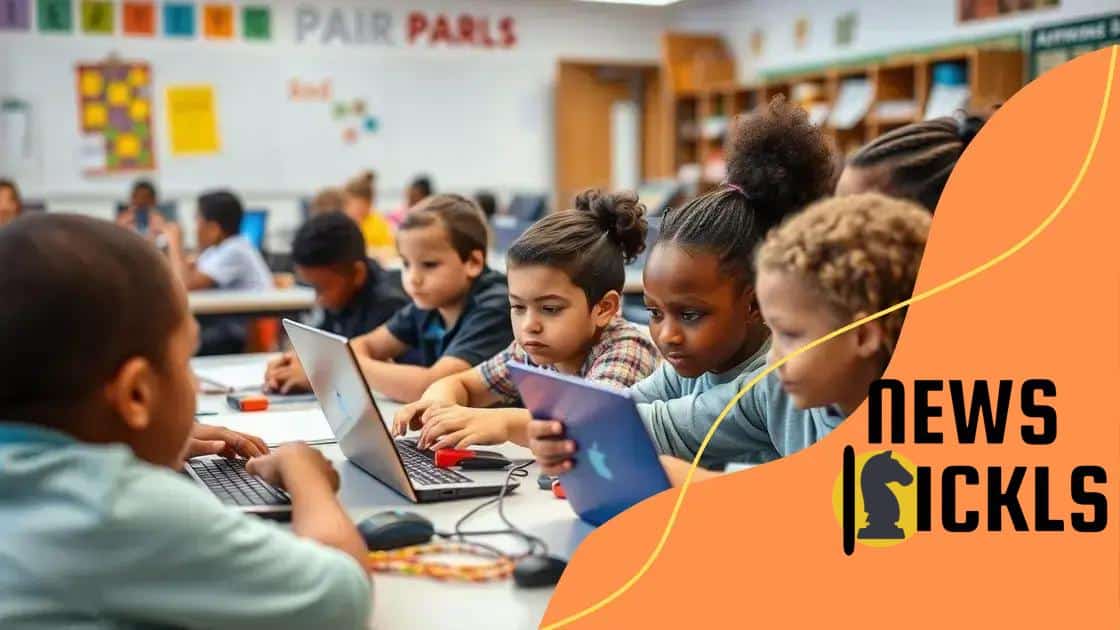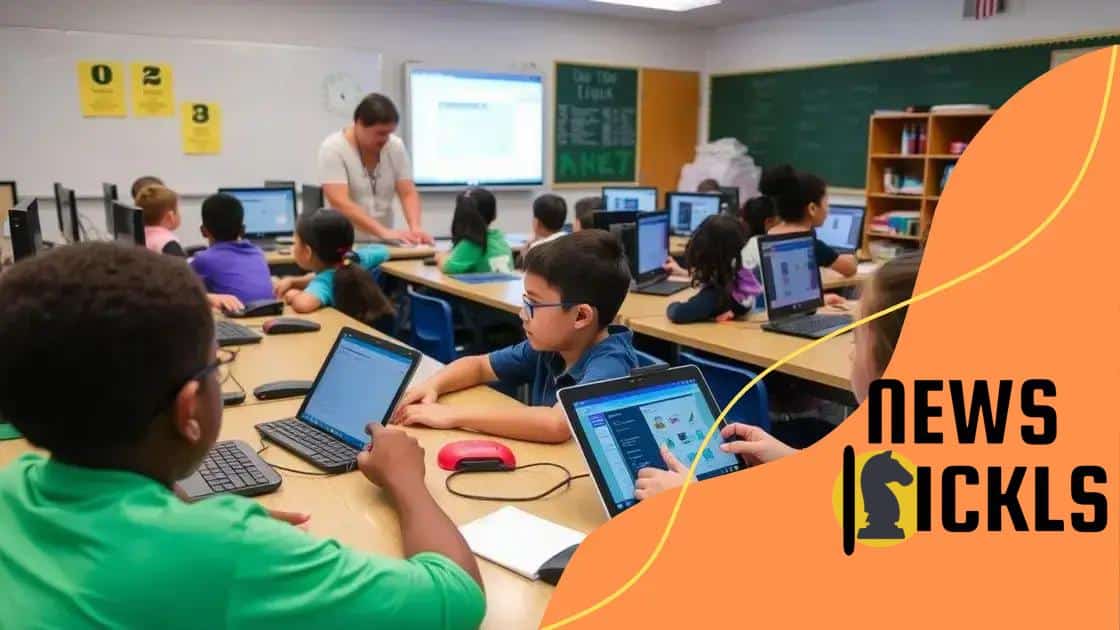The importance of coding literacy in K-12 education

The importance of coding literacy in K-12 education lies in its ability to prepare students for future careers by fostering critical thinking, problem-solving, and creativity through integrated and engaging curricula.
The importance of coding literacy in K-12 education cannot be overstated. As technology continues to evolve, equipping young minds with coding skills is essential for navigating the digital world effectively. How does coding literacy shape our future generations?
Understanding coding literacy in K-12
Understanding coding literacy in K-12 is essential as we prepare students for a world filled with technology. Coding is not just about writing lines of code; it’s about problem solving and critical thinking. Students learn to express their ideas through technology, which is a vital skill in today’s job market.
What is Coding Literacy?
Coding literacy refers to the ability to read, write, and understand code. This skill helps students communicate with computers and understand how software operates. Through coding, students can create their own websites, games, and applications, giving them a sense of accomplishment and creativity.
Benefits of Coding Literacy
- Coding enhances problem-solving skills.
- It promotes logical thinking and creativity.
- Students gain confidence through hands-on projects.
- Coding can lead to better job opportunities in the future.
As students dive into coding literacy, they learn how to collaborate with others. Working on coding projects encourages teamwork, which is crucial in most workplaces. Additionally, coding boosts resilience as learners encounter challenges and work through them.
Understanding coding literacy also helps students appreciate the technology they use daily. They begin to see technology not just as consumers, but as creators. This shift in perspective is empowering and prepares them for a future where technology plays a central role in society.
How Schools Can Support Coding Literacy
Schools can support coding literacy through dedicated programs and curricula. Offering after-school coding clubs can spark interest among students. Integrating coding into subjects like math and science makes learning more engaging. Educators trained in coding can better guide students, fostering a deeper understanding of technology.
Incorporating games and interactive tools in the classroom can make learning to code fun. As students enjoy these activities, they are more likely to embrace coding literacy as a valuable skill. Coding literacy paves the way for innovation and creativity in education, ensuring students are ready for the digital age.
Benefits of coding skills for students
The benefits of coding skills for students extend beyond simply learning to write code. These skills help students develop important life qualities, such as creativity, critical thinking, and problem-solving abilities. In today’s digital age, understanding coding is as crucial as learning to read and write.
Enhancing Problem-Solving Abilities
Coding encourages students to approach challenges methodically. As they design and debug programs, they learn to break problems into smaller parts, making it easier to tackle projects piece by piece. This process fosters a growth mindset, where failure is viewed as a stepping stone to success.
Encouraging Creativity
Students who learn coding can express their ideas and creativity through technology. They can create games, websites, and apps, transforming their imaginative concepts into tangible projects. This hands-on experience boosts their confidence and allows them to see their ideas come to life.
- Coding promotes innovation by allowing students to experiment.
- It nurtures a sense of achievement when students complete projects.
- Students learn to collaborate on coding projects, enhancing teamwork skills.
- Coding sense opens doors to various career paths in technology.
Furthermore, learning to code can improve students’ math and logic skills. Since coding often involves algorithms and data structures, students strengthen their understanding of complex concepts that can be applied in other areas of study. Strong coding skills prepare students for future job opportunities in a tech-driven economy.
Overall, the benefits of coding skills for students create a strong foundation for lifelong learning. As they acquire these skills, they become adept at using technology to address real-world problems. This adaptability is essential in an ever-changing job market, ensuring students can thrive in any environment.
Incorporating coding into the curriculum

Incorporating coding into the curriculum is essential for preparing students for their futures in a technology-driven world. As digital literacy gains importance, schools must adapt by integrating coding into various subjects, making it a fundamental part of education.
Why Integrate Coding?
Integrating coding fosters critical thinking and problem-solving skills. When students engage with coding, they learn to analyze problems, think logically, and develop solutions. These skills are applicable not only in technology but also across all academic fields.
Subjects That Benefit from Coding
Coding can enhance several subjects. For example:
- Math: Coding teaches students how to work with algorithms and data analysis.
- Science: Creating simulations and models helps students visualize scientific concepts.
- Art: Students can learn to create digital artwork or interactive presentations.
- History: Coding can be used to design projects that simulate historical events.
By blending coding with these subjects, students see real-world applications of their learning. It also keeps them engaged and motivated, using technology in ways that are relevant to their lives. This integration promotes creativity and encourages innovation.
Coding clubs and elective courses can further enrich a student’s learning experience. These extracurricular activities allow students to explore coding on a deeper level. Schools can also collaborate with local tech companies to offer workshops and resources, enhancing the curriculum.
Overall, incorporating coding into the curriculum lays a foundation for students to thrive in the future. As they become more adept at using technology creatively, they will be better equipped to succeed in a rapidly changing world.
Challenges in teaching coding in schools
Teaching coding in schools presents various challenges that educators must navigate. While the value of coding in education is clear, several obstacles can hinder its successful implementation in the classroom.
Limited Resources
Many schools struggle with a lack of resources. This includes insufficient access to computers, software, or reliable internet connections. Without appropriate tools, teaching coding becomes difficult. Teachers might also lack training in the latest programming languages, leading to a gap in knowledge.
Curriculum Overload
With established subjects like math, science, and language arts already in the curriculum, finding time for coding can be tough. Teachers must balance existing requirements while integrating coding lessons. This can lead to a diluted focus on coding education.
- Time constraints affect lesson planning.
- Teachers may prioritize other subjects over coding.
- Limited class periods make it hard to cover complex topics.
Another significant challenge is the varying skill levels of students. Some students may already have experience with coding, while others may be complete beginners. This difference can create a gap in learning and make it hard for teachers to tailor lessons effectively.
Additionally, students may face frustrations when learning to code. Programming often involves debugging errors, and not every student responds positively to this challenge. Some may feel discouraged and give up if they find coding too difficult.
Despite these challenges, educators are finding innovative solutions. Schools can collaborate with local tech organizations to provide training and resources. Additionally, ongoing professional development for teachers helps build confidence and expertise in teaching coding.
Incorporating a variety of teaching methods can also engage students effectively. Hands-on projects, gamified learning, and peer collaboration can create a supportive environment that fosters interest in coding.
Future trends in coding education
Future trends in coding education are evolving rapidly as technology continues to advance. As society becomes more reliant on technology, educators are rethinking how to teach coding to prepare students for the workforce of tomorrow.
Emphasis on Computational Thinking
One major trend is the emphasis on computational thinking. This approach teaches students how to break down complex problems into manageable parts. Rather than focusing solely on programming languages, educators are encouraging students to understand the underlying logic behind coding. This skill will help them adapt to new technologies as they emerge.
Integration of Artificial Intelligence
Artificial intelligence (AI) is becoming part of the coding curriculum. Students will learn how to interact with AI tools and use them in their projects. Understanding AI will be important as these technologies become more prevalent in our daily lives. Students can create projects that utilize AI for tasks such as data analysis or even game design.
- AI tools help students learn coding concepts more easily.
- Integrating AI promotes innovative thinking.
- Students will gain skills relevant to future job markets.
Another important trend is the use of gamification in coding education. Game-based learning captures students’ interest and makes coding fun. By incorporating game design elements, teachers can engage students in challenging coding tasks without overwhelming them. This approach allows learners to explore coding concepts in a low-pressure environment.
Collaboration is also becoming more critical in coding education. Tools that enable teamwork empower students to work together on coding projects. This collaborative environment mirrors workplaces where teamwork is essential, preparing students for future careers.
Furthermore, remote learning is a growing trend in coding education. With the rise of online courses and resources, students can learn coding from anywhere. Educators are embracing hybrid learning models that include both online and in-person sessions. This flexibility allows more students access to coding education, especially those in underserved areas.
In conclusion, the future of coding education holds immense potential for students. As we look ahead, it becomes clear that integrating coding into school curricula is not just an option but a necessity. With trends like computational thinking, AI integration, gamification, and hybrid learning, we can prepare students for a technology-driven world. Emphasizing teamwork and remote learning opportunities will ensure that all students have access to the skills they need. Ultimately, fostering a strong foundation in coding will equip students to thrive in their future careers.
FAQ – Frequently Asked Questions about Coding Education
Why is coding education important for students?
Coding education equips students with essential skills for future careers, promoting critical thinking, problem-solving, and creativity.
What are some challenges in teaching coding in schools?
Challenges include limited resources, curriculum overload, varying skill levels among students, and keeping students motivated.
How can AI be integrated into coding education?
AI can help students learn by providing personalized feedback, facilitating coding exercises, and enhancing engagement through interactive tools.
What future trends should we expect in coding education?
Future trends include a focus on computational thinking, gamification, remote learning opportunities, and teamwork to enhance coding skills.






